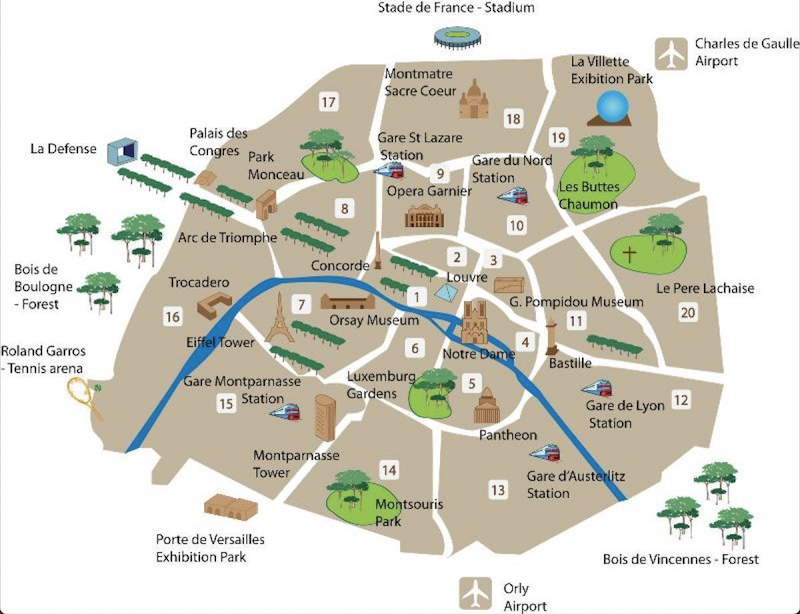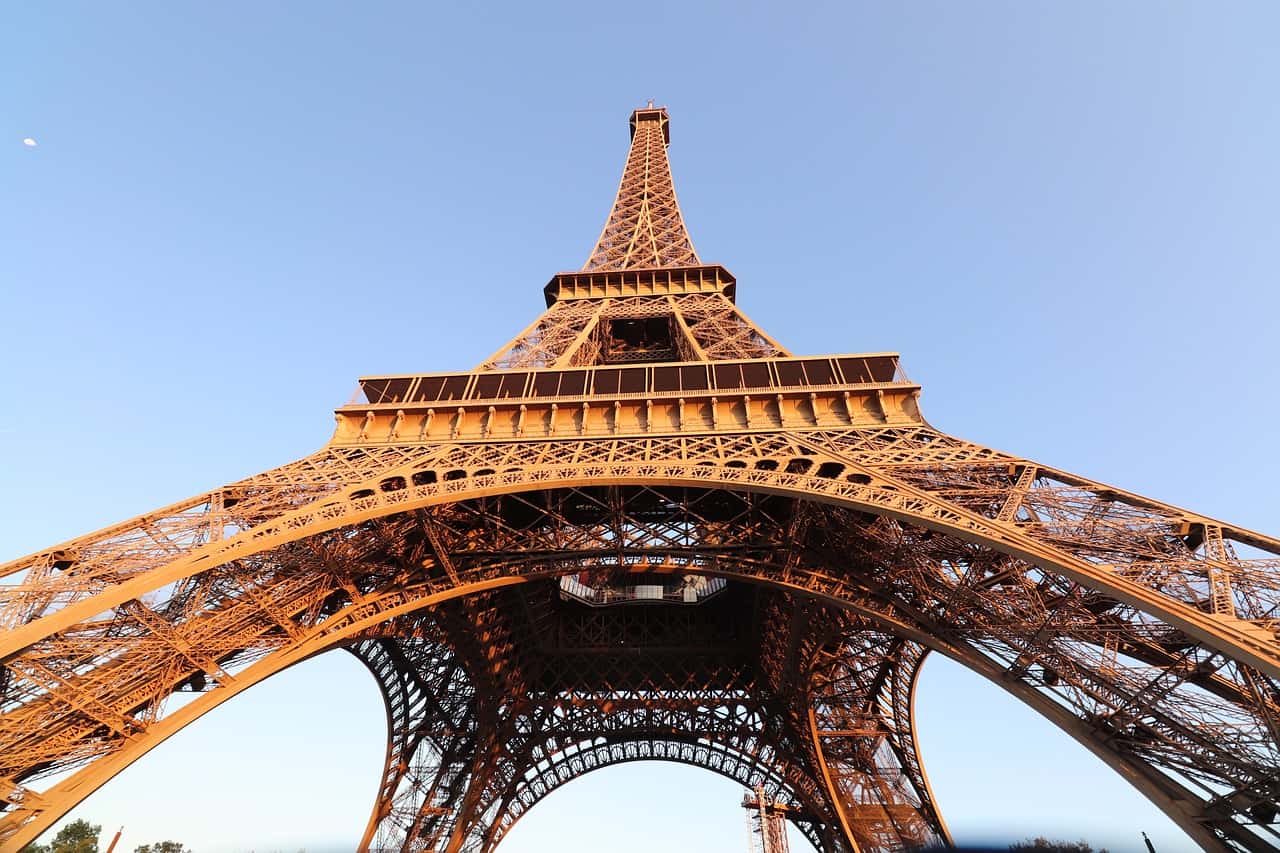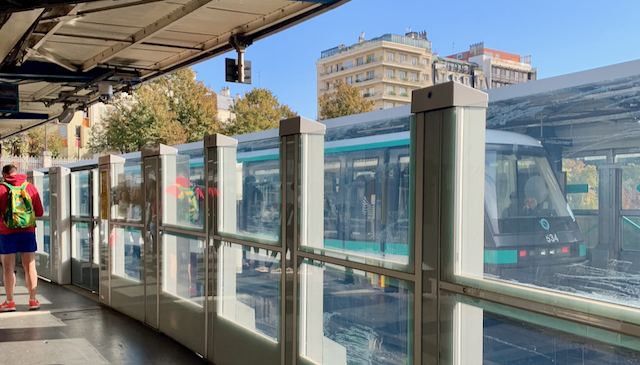Paris for First-Time Visitors
Welcome to the enchanting world of Paris, a city that needs no introduction yet always manages to captivate the heart of every traveler, especially those embarking on their first-time Paris visit. Know before you go! Paris is a city of romance, history, art, and gastronomy, a place where every cobblestone street seems to whisper tales of its rich past. For first-time visitors, the task of navigating this sprawling metropolis might feel daunting, but fear not, for this guide is here to be your compass. Join me as we uncover the secrets of selecting the perfect arrondissement to call home during your stay, offer insights into the city’s intricate transportation system, reveal the must-see sights that have captured the world’s imagination, provide tips on dressing like a local, share etiquette for tipping, and open the doors to Paris’s vibrant dining scene. So, put on your walking shoes, embrace the art of flânerie, and let the City of Light cast its irresistible spell upon you.

How do I pick which Arrondissement to stay in Paris?
Location. Location. Location. First of all, think of an arrondissement as a ‘section’ of the city, organized by numbers (that swirl in a circle). Thnk burroughs, districts or neighborhoods to simplify it. Each has its own charm. To ensure you have a wonderful trip to Paris, start by picking the right hotel location. There are 20 Arrondissements (each their own district with a mayor and not to be confused with neighborhoods). This post will take you up to the 8th, skipping Arr. 2 (commercial area).
Arr. 1 is the city center and the numbers spiral out from there in a circle (view the map in the photos below). Typically, the closer to the city center, the better, often more costly but near to key landmarks, though each has its own charm. This district is home to some of the most famous buildings and landmarks in the French capital. A must-visit includes Ile de la Cité, Place Vendôme, Pont Neuf, the Tuileries Gardens, the Louvre, and the Seine River. Learn more about arrondissements here.
Arr. 3 is home to Le Marias, a trendy, charming shopping area with galleries, boutiques, and cafés.
Arr. 4 includes the other half of Le Marais, the other half of Isle de la Cité, the Pompidou Center (with George’s restaurant on top – highly recommend), and Notre Dame. It’s also a great place to stay, and the gay district of Paris.
Arr. 5, or Latin Quarter is notable for its ancient streets and the Sorbonne University.
Arr. 6, Saint-Germain-des-Près is great for foodies with many gourmets, chocolate, and pastry shops.
Arr. 7 is home to the Eiffel Tower, big avenues, and private luxe mansions, and is known as the bourgeois district. You’ll also find the Tomb of Napoleon here and the Orsay Museum. For an unusual tour, check out the Paris Sewer Museum.
And the 8th, my personal favorite and most romantic is where you’ll find the famous “Golden Triangle”, the best cabarets, luxury shopping, and beautiful views from the top of the Arc de Triomphe.
Best Areas to Stay When Visiting Paris For First-Time Visitors

The Top 5 Locations to Stay in Paris for First-Time Visitors
If you’re new to Paris and wondering where to make your base, we’ve got you covered. It can be daunting for first-time visitors. Explore my top five areas for first-time visitors to stay and experience the essence of the city. From the upscale glamour of the 8th arrondissement to the artistic allure of Saint-Germain-des-Prés and the vibrant energy of the Marais, each neighborhood offers a unique perspective on Parisian life. Whether you seek iconic landmarks, chic boutiques, or peaceful residential streets, discover the perfect starting point for your Paris adventure. On the luxury end, the Four Seasons Hotel George V Paris is perfect for first-time visitors, in the mid-range, all of the Astotels are great, and on the two0star budget side, Hotel Elysée Etoile. Air BNB’s are also great options for longer stays.
- The 8th arrondissement: This upscale neighborhood is known for its prestigious avenues, luxury shopping, and high-end hotels. It’s a great place to stay if you want to be close to the Champs-Elysées and other major attractions.
- Saint-Germain-des-Prés: This upscale neighborhood is known for its elegant boutiques, art galleries, and upscale restaurants. It’s a great place to stay if you want to be close to the Louvre Museum and other cultural attractions.
- The Marais: This lively neighborhood is known for its chic boutiques, trendy restaurants, and historic landmarks. It’s a great place to stay if you want to be in the heart of the city and be within walking distance of many of Paris’ top attractions.
- The 7th arrondissement: This neighborhood is known for its iconic landmarks, such as the Eiffel Tower and the Musée d’Orsay, as well as its upscale shopping and dining options. It’s a great place to stay if you want to be close to these iconic attractions.
- The 16th arrondissement: This residential neighborhood is known for its tree-lined streets, upscale shopping, and spacious parks. It’s a great place to stay if you want a more residential feel while still being within easy reach of the city center.

Transportation in Paris for First-Time Visitors
Nothing beats walking the charming streets of Paris. But if you have a lot of ground to cover, consider public transportation, an easy and convenient way to explore the city.
- Metro: The Paris Metro is a fast and efficient way to get around the city. It operates from around 5:30 am to 1:00 am and has 14 lines covering most of the city.
- Bus: The Paris bus system is another option for getting around the city. It operates from around 6:00 am to 8:30 pm and covers a larger area than the metro.
- Bicycle: Paris has a large network of bike lanes and bike-sharing stations. You can rent a bike through the Velib bike-sharing program or bring your own.
- Walking: Paris is a very walkable city, and many of the main attractions are within easy walking distance of each other. Walking is a great way to explore the city and discover hidden gems.
- Ubers and Taxis: Prices vary and are based on demand, time of day, and distance traveled. There are several taxi companies in Paris that can be pre-booked or hailed at or near stands such as hotels and landmarks. Meters start at roughly 2€ and often have minimums, of 6€. Not all take credit cards (cartes bancaires) so have some Euros on hand. Taxi G7 does take credit cards and is the largest taxi company in Europe. Due to language barriers, have the destination address written down, or carry a card from your hotel.
Tours and Sightseeing in Paris for First-Time Visitors
Whenever we go to a new city, we spend the first day doing a Hop-On-Hop-Off type tour without getting off – this will give you a sense of the place and a better geographical understanding, plus, some sights are worth a glimpse without a full visit. If you’re planning on booking guided tours, start early. For top sights like the Eiffel Tower (9 million visitors/year), book a priority-access guided tour, so you spend more time enjoying a little time in the lines. BTW, the Eiffel Tower has a couple of amazing Michelin-starred restaurants, which also need sufficient time to book well in advance. Consider buying The Paris Pass, which gives you access to over 75 attractions and tours, a 1-day hop-on, hop-off bus tour ticket, a Paris Museum Pass giving you access to many of the city’s museums and landmarks, and more. If you’re sticking to museums, consider just the Paris Museum Pass which enables you to visit more than 60 of the top museums and monuments in and around Paris including the Louvre, Versailles, and the Centre Pompidou.
Ten essential must-see sites when visiting Paris for first-time visitors
-
The Eiffel Tower (Arr. 8) symbolizes Paris. Nothing like doing this in person, though it’s a highly visible landmark that can be seen from many points in the city, and Seine River Tours.
-
Louvre Museum – (Arr. 1) On our first visit, we attempted to see everything. Don’t. You just can’t. It’s too big. View what inspires you and of course, see Leonardo di Vinci’s Mona Lisa and two famous Greek statues, Venus de Milo and the Winged Victory of Samothrace. Figure out your strategy before you enter.
-
Musée d’Orsay – Possibly my favorite Museum. Also recently learned during our visit to Philly’s Barnes’ Foundation, that they have reciprocal entry. Enjoy their magnificent collection of world-famous Impressionist and Post-Impressionist art including Van Gogh’s Starry Night. The skip-the-line ticket is well worth it during busy seasons.
-
Versailles Palace – one of largest palaces in the world, it’s most famous for its occupants, the Hall of Mirrors and the magnificent gardens. A guided tour here is well worth it as the security line will go faster, plus they’ll typically take care of transportation since Versaille is about 12 miles from the city.
-
The Marais – (Arr. 3 & 4) – Very hip, trendy with cobblestone streets, boutiques, museums, and gardens. It’s the perfect neighborhood in Paris for flâner, wandering aimlessly around the city to experience it. There are walking tours but we’ve always enjoyed meandering in and out of the streets.
-
Latin Quarter (Arr. 5) in the Left Bank – explore the narrow, winding, cobblestone streets that remind us of what the medieval city of Paris looked like. Also home to the Sorbonne and the Pantheon.
-
Seine River – It defines the Left Bank from the Right Bank, cutting through the city. I think the nicest way to see is to walk its banks, but river tours are also a relaxing way to take in the river and the city. Île de la Cité, is one of two islands with medieval masterpieces, parks, and Notre Dame Cathedral. Due to the 2019 fire, this cathedral was closed for renovation, and has since reopened.
-
Montmartre and Sacré Coeur – (Arr. 18) The entrance is free, with no guided visits. It’s atop a hill and visible from almost everywhere. There are no elevators either. Word of caution, we have seen more than one pick-pocket incident here, so keep your belongings close and don’t put them down to get that selfie.
-
Arc de Triomphe – This iconic landmark was commissioned in 1806 by Napoleon. Definitely do the observation deck at the top for 360 degree views.
-
The Paris Passages – They’re the city’s original shopping malls and full of tiny boutiques, bookstores, antique shops, cafés, and more uniquely Parisian spots. Explore Galerie Vivienne, Passage des Panoramas, Galerie Véro-Dodat, and Passage Colbert.
What Should You Wear When Visiting Paris?
This is a very common question with a surprisingly simple answer. Also, note that shopping in Paris is FUN! Even the Nike stores carry completely different goods than the US (and other countries), so even if shopping isn’t on your itinerary, you may be surprised by the accidental boutique detour or flea market (where I bought my first Couture Dior blazer which I still wear 20 years later). Don’t be afraid to express your personal style while still being mindful of local customs.
Paris is a cosmopolitan city with a diverse population, and people generally dress in a wide range of styles. There are no hard and fast rules about what tourists should wear, but there are a few general tips you can follow to blend in and feel comfortable:
- Dress in layers: The weather in Paris can be unpredictable, so it’s a good idea to dress in layers that you can easily add or remove as needed. A light jacket or sweater can be useful for cooler days, and a scarf is always a good idea to have on hand.
- Avoid wearing shorts: While shorts are common in some parts of the world, they are not as widely worn in Paris, particularly by women. If you want to blend in with the locals, you may want to avoid shorts and opt for pants or a skirt instead.
- Wear comfortable shoes: Paris is a city with a lot of walking, so it’s important to wear comfortable shoes that you can walk in for long periods of time. Avoid high heels if you can, as the cobblestone streets can be difficult to navigate in stilettos. (carry them in a backpack and change at your destination)
- Be respectful of local customs: While Paris is a relatively liberal city, it’s always a good idea to be mindful of local customs and dress modestly. Avoid revealing clothing or clothing with offensive graphics or slogans.
Should You Tip in Paris?
In Paris, it is customary to leave a small tip in restaurants, bars, and cafes, although it is not required. The average tip is about 10% of the total bill, although some people choose to leave a little more or a little less depending on the service. You can simply round up the bill to the nearest euro or add a few euros to the total. For example, if your bill comes to €27.50 euros, you could round up to €30 euros or add a few euros to the total. Note that many places expect tips in cash, and don’t allow you to simply add it to your credit card, though you can ask when you get your bill.
It is also common to tip hairdressers, taxi drivers, and other service providers in Paris, although the amount can vary. Some people choose to tip a few euros for these services, while others tip a percentage of the total bill. If you are unsure of how much to tip, you can ask the service provider or a local for guidance.
In general, it is always a good idea to be gracious and show appreciation for good service, but remember that tipping is not expected in all situations and is ultimately up to your discretion.
Is it Safe to Travel to Paris?
Traveling to Paris is generally considered safe for tourists. Like any major city, it’s essential to exercise typical precautions, such as staying aware of your surroundings, safeguarding your belongings, and being cautious in crowded tourist areas, but Paris remains a popular and welcoming destination for travelers from around the world.
Dining in Paris
I was actually going to attempt writing about where to eat but quickly realized I’d be typing for days. There are so many great places, and many of my favorite meals were actually random finds as I explored the city. Use The Fork app or OpenTable, and Google when you’re hunting and on the ground. Rest assured that no matter your schedule, budget, or dining preferences, you’ll be in foodie heaven. Don’t be afraid of trying some new menu items like frois gras. The French are the masters! I’ve not personally taken a food tour, but I’ve heard from fellow travelers that they are incredible — especially the chocolate and pastry tours.
Conclusion~Final Thoughts
In conclusion, embarking on your first trip to Paris promises an enchanting experience in a city brimming with romance, history, art, and culinary delights. With the guidance provided in this comprehensive guide, you’ll be well-prepared to navigate the arrondissements, make the most of the city’s transportation options, and explore its iconic landmarks. Remember to dress comfortably and respectfully, embrace local customs, and consider tipping modestly when dining out or using services.
Ultimately, Paris is a safe and welcoming destination, and your visit is bound to leave you with cherished memories and a deeper appreciation for the City of Light’s unique charm and allure.
Bon voyage!
Suggested Reading:



